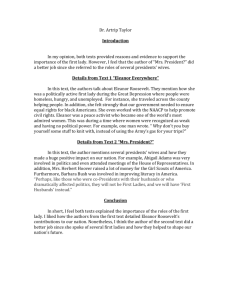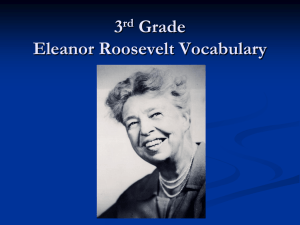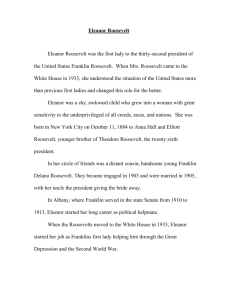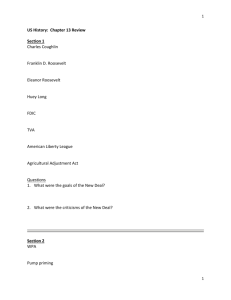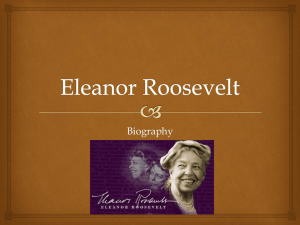Social Studies- Lesson #4 Controversial Issue
advertisement
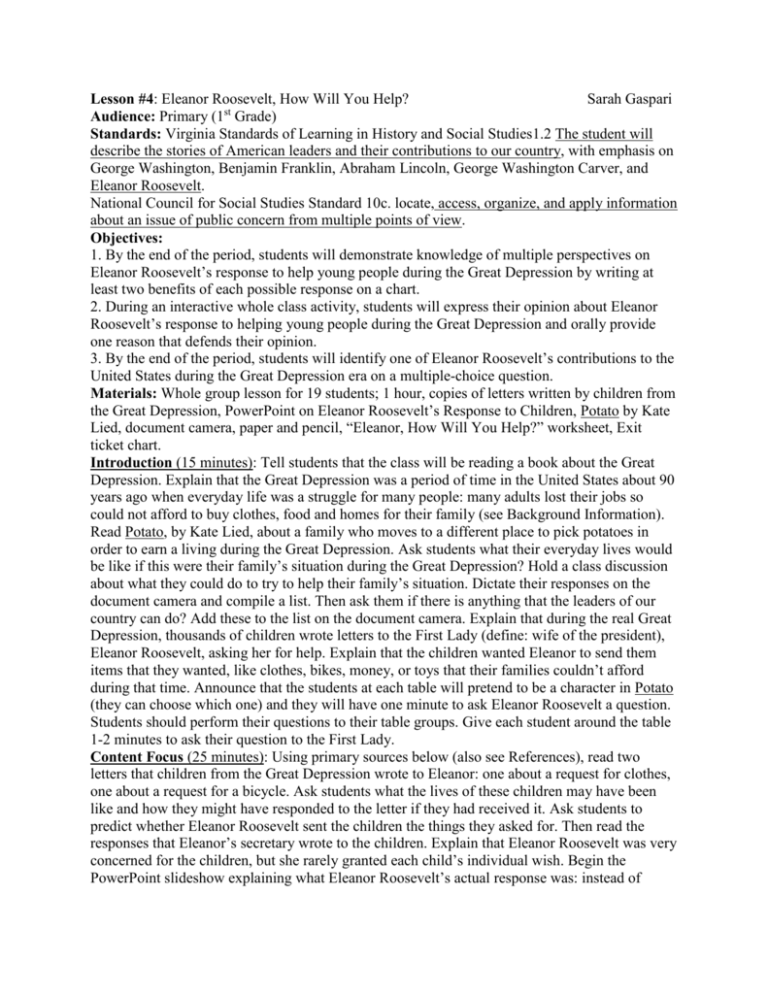
Lesson #4: Eleanor Roosevelt, How Will You Help? Sarah Gaspari st Audience: Primary (1 Grade) Standards: Virginia Standards of Learning in History and Social Studies1.2 The student will describe the stories of American leaders and their contributions to our country, with emphasis on George Washington, Benjamin Franklin, Abraham Lincoln, George Washington Carver, and Eleanor Roosevelt. National Council for Social Studies Standard 10c. locate, access, organize, and apply information about an issue of public concern from multiple points of view. Objectives: 1. By the end of the period, students will demonstrate knowledge of multiple perspectives on Eleanor Roosevelt’s response to help young people during the Great Depression by writing at least two benefits of each possible response on a chart. 2. During an interactive whole class activity, students will express their opinion about Eleanor Roosevelt’s response to helping young people during the Great Depression and orally provide one reason that defends their opinion. 3. By the end of the period, students will identify one of Eleanor Roosevelt’s contributions to the United States during the Great Depression era on a multiple-choice question. Materials: Whole group lesson for 19 students; 1 hour, copies of letters written by children from the Great Depression, PowerPoint on Eleanor Roosevelt’s Response to Children, Potato by Kate Lied, document camera, paper and pencil, “Eleanor, How Will You Help?” worksheet, Exit ticket chart. Introduction (15 minutes): Tell students that the class will be reading a book about the Great Depression. Explain that the Great Depression was a period of time in the United States about 90 years ago when everyday life was a struggle for many people: many adults lost their jobs so could not afford to buy clothes, food and homes for their family (see Background Information). Read Potato, by Kate Lied, about a family who moves to a different place to pick potatoes in order to earn a living during the Great Depression. Ask students what their everyday lives would be like if this were their family’s situation during the Great Depression? Hold a class discussion about what they could do to try to help their family’s situation. Dictate their responses on the document camera and compile a list. Then ask them if there is anything that the leaders of our country can do? Add these to the list on the document camera. Explain that during the real Great Depression, thousands of children wrote letters to the First Lady (define: wife of the president), Eleanor Roosevelt, asking her for help. Explain that the children wanted Eleanor to send them items that they wanted, like clothes, bikes, money, or toys that their families couldn’t afford during that time. Announce that the students at each table will pretend to be a character in Potato (they can choose which one) and they will have one minute to ask Eleanor Roosevelt a question. Students should perform their questions to their table groups. Give each student around the table 1-2 minutes to ask their question to the First Lady. Content Focus (25 minutes): Using primary sources below (also see References), read two letters that children from the Great Depression wrote to Eleanor: one about a request for clothes, one about a request for a bicycle. Ask students what the lives of these children may have been like and how they might have responded to the letter if they had received it. Ask students to predict whether Eleanor Roosevelt sent the children the things they asked for. Then read the responses that Eleanor’s secretary wrote to the children. Explain that Eleanor Roosevelt was very concerned for the children, but she rarely granted each child’s individual wish. Begin the PowerPoint slideshow explaining what Eleanor Roosevelt’s actual response was: instead of spending a lot of time and money responding to each individual child, Eleanor Roosevelt used her intelligence, kindness, desire to help people, and her powerful position as First Lady to create programs that would benefit thousands of young people. Describe the National Youth Administration as a program she established that helped children by allowing them to stay in school and giving them opportunities to work to earn money for themselves and for their families. Explain how this program helped 2 million high school and college students, and also found work for 2.5 million who were unable to go to school. Explain that Eleanor Roosevelt chose to help children this way because by keeping them in school and helping them get jobs, they would learn knowledge and working skills to help them for the rest of their lives. Offer an alternative perspective by saying that if Eleanor Roosevelt had chosen instead to respond to the letters and grant as many of the children’s requests as possible, then she would have helped by giving them exactly what they wanted very soon after they asked for it (though it is fair to mention that it is unlikely she would have been able to respond to all 300,00 children who wrote to her). Tell students that it is up to them to decide what they think and how they feel about Eleanor Roosevelt’s response. Ask students to demonstrate what they believe about Eleanor’s response by having them to walk and stand on the “I agree/I like” side of the room (the right side, if standing at the teacher’s desk). If students disagree with her response and believe that it was better to send children the things they asked for, have these students stand on the left side of the room. If students have mixed feelings or have not decided, direct them to stand in the middle of the room. Go around the room, calling on each student and ask them to defend why they chose to stand where they did (why do they agree/disagree/are in the middle). After each student has spoken, explain that there is no “right” answer; there are many ways to help people, some ways have different benefits than others. Closure (20 minutes): Students should return to their seats. Explain that even though you may believe one option is better than the other, it is very important to be able to understand each choice. Pass out the worksheet (see below) and ask students to complete it by writing down the benefits of the two discussed ways that Eleanor Roosevelt could have helped these children (one way would have been by sending them the items they requested, another way was creating the National Youth Administration to help them stay in school and find jobs). Read the headings on the chart to the class to ensure that students understand where to write their responses. Students should complete the worksheet individually but may consult their table if they need help. Collect the papers when completed for assessment. As an exit ticket, ask students the multiple-choice question and record responses on a sheet. Evaluation: Formative: Informal observations of student participation and discussion comments during whole class discussion and Eleanor Roosevelt Response Discussion. Summative: Students will fill out a chart explaining the benefits of each option that Eleanor Roosevelt could have used to help children. Students will answer the multiple choice question: During the Great Depression, what did Eleanor Roosevelt do to help young people who were struggling to afford many things? a. Eleanor sent all young people whatever they wanted. b. Eleanor did not help young people at all. c. Eleanor created the National Youth Administration to help young people go to school and get jobs. d. She gave money to all young people. Letter from a child asking for clothes Granette, Ark. Nov. 6, 1936 Dear Mrs. Roosevelt I am writing to you for some of your old soiled dresses if you have any. As I am a poor girl who has to stay out of school. On account of dresses & slips and a coat. I am in the seventh grade but I have to stay out of school because I have no books or clothes to ware. I am in need of dresses & slips and a coat very bad. If you have any soiled clothes that you don't want to ware I would be very glad to get them. But please do not let the news paper reporters get hold of this in any way and I will keep it from geting out here so there will be no one else to get hold of it. But do not let my name get out in the paper. I am thirteen years old. Yours Truly, Miss L. H. Gravette, Ark. R #3 c/o A. H. Reply to the Clothes Letter: November 13, 1936 My dear Miss H: Mrs. Roosevelt and her Secretary are away and in their absence I have been asked to acknowledge their mail. I know Mrs. Roosevelt would be very sorry to hear of your difficulties. However, she would be unable to comply with your request as there are certain persons to whom she sends the clothing for which she has no further use. Very sincerely yours, [no signature] Letter from a child asking for a bicycle Sikeston, Missouri January 20, 1938 Dear Mrs. Roosevelt, I am writing this letter in hopes that you will answer in my favor. My father H. C. has been in bed from a stroke for almost a year. We have no money and my brother works but makes $3.00 a week and there are eight in our family. My step-mother is very good to me and I try to help her. She takes in washings and I have to walk for six or eight blocks and then carry the washings home. I have to go of a morning before school and it has been very cold here. If you could send me a bicycle to ride when I go after washings for her I shall appreciate it. I am in eighth grade at school and work very hard to make passing grades. The Principal of the school bought two of my sisters and me a pair of slippers so we would not have to stay at home. If you would do this for me I shall be able to help my step-mother more. If you send me one I would like a girls bicycle. I am about 4 feet 3 inches tall so if you send me one you can judge as to what size. Loving and appreciatingA. L. C. Response to Bicycle Letter: January 25, 1938 My dear A. L. C.: Mrs. Roosevelt asked me to acknowledge your letter. She is very sorry to hear of your parents' difficulties but regrets that she cannot do as you ask. She receives so many requests similar to yours that she finds it impossible to comply with them, much as she would like to do so. With many regrets, I am Very sincerely yours, Malvina T. Scheider Secretary to Mrs. Roosevelt Eleanor Roosevelt, how will you help? Write down the benefits of each response Eleanor could have taken to help young people during the Great Depression. Send children items they asked for Create ways for children to go to school and get jobs Circle the response you believe is best. Background Information About one hundred years ago, in the 1920s, America was a very wealthy place where more and more people had a lot of extra money to spend. But then, businesses started to fail and millions of people lost their jobs. Families all across the United States struggled to pay for things they needed like homes and clothing, and many more families no longer had extra money to spend on gifts and toys. This period of American history is called The Great Depression. Eleanor Roosevelt was the First Lady, which means she was the wife of the president, during a part of this time period. Eleanor believed that it was very important to help people, especially if they are being treated unfairly or are struggling. Eleanor saw that adults and children alike all of the United States were struggling to live their day-to-day lives. Children began writing to Eleanor Roosevelt asking for her help. In fact, over 300,000 children wrote to Eleanor and asked her to send them things like money, clothes, bicycles and toys (“Dear Mrs. Roosevelt,” 2003). Eleanor had so many letters that there was no way she could respond to all of them. Her secretary wrote back to most of the children, telling them that Mrs. Roosevelt could not send them what they wanted. Eleanor Roosevelt was busy working on a different way to help the children and young people struggling during the Great Depression. Eleanor Roosevelt helped to establish the National Youth Administration in 1935. This was a program created by the government that helped millions of children stay in school by giving them money in exchange for work (“Dear Mrs. Roosevelt,” 2003). It also helped children who were not in school to find jobs so that they could earn money to pay for food, clothing and other things they needed to survive. Eleanor Roosevelt helped over 4 million young people to learn and develop skills to help them get jobs for many years. Eleanor Roosevelt had at least two choices when deciding how to help young people in America: she could answer as many of the children’s letters as she could and give them what they requested as quickly as possible, or she could work hard to create one or more programs that would help a large amount of these children for many years to come. There is no right answer, because each choice helps children but in different ways. By choosing to send them the things they requested in the letters, Eleanor would have helped them quickly and would have given them exactly what they asked her for. By creating a program to keep them in school and help them find jobs, Eleanor also helps them because the children learn skills and knowledge that will allow them to work at many jobs and earn money for themselves or their families. Leaders in our government like Eleanor have to make tough decisions about the best ways to help people. Students should be encouraged to think about what they believe and feel is the best choice to help young people during the Great Depression. It is important to explain the benefits of each choice and allow students to choose freely. When students are explaining their choice, they will be asked to only discuss the option that they chose, and not mention the other option in order to respect the opinions of those who think differently. References “Dear mrs. roosevelt: Response to the letters.” (2003). New deal network. Retrieved November 16, 2014, from http://newdeal.feri.org/eleanor/er4a.htm. “Dear mrs. roosevelt: The letters.” (2003). New deal network. Retrieved November 16, 2014, from http://newdeal.feri.org/eleanor/er4a.htm. “First Lady Biography: Eleanor Roosevelt. (n.d.). National first ladies library. Retrieved November 15, 2014, from http://www.firstladies.org/biographies/firstladies.aspx?biography=33. Lied. K. (1997). Potato. Washington, D.C.: Publishers Group West. Potential student responses to Potato (to be listed on document camera) They could sell some of the extra potatoes they picked for themselves They could all look for a job They could live with another family They could ask their friends for help or money They could tell the President about how they don’t have any money for food They could tell the President that they needed a job They could ask the government to give them food Expected Results: Eleanor Roosevelt, how will you help? Write down the benefits of each response Eleanor could have taken to help young people during the Great Depression. Send children items they asked for They get what the clothes or bike they wanted They get it right away Create ways for children to go to school and get jobs They get to go to school and learn things If they are smart they can get a job They get money when they have a job Circle the response you believe is best: Student will circle the right column Exit Ticket Responses Question: During the Great Depression, what did Eleanor Roosevelt do to help young people who were struggling to afford many things? a. Eleanor sent all young people whatever they wanted. b. Eleanor did not help young people at all. c. Eleanor created the National Youth Administration to help young people go to school and get jobs. d. She gave money to all young people. Student name Response Expected Exit Ticket Response: During the Great Depression, what did Eleanor Roosevelt do to help young people who were struggling to afford many things? a. Eleanor sent all young people whatever they wanted. b. Eleanor did not help young people at all. c. Eleanor created the National Youth Administration to help young people go to school and get jobs. d. She gave money to all young people.

